Objective of Calibration
A calibrated measuring instrument is indispensable for:
- Taking precise measurements with well-known measurement uncertainty
- Taking measurements the results of which are commensurable
- Granting legal security as the results of the measurements taken can be traced to the respective national calibration standards
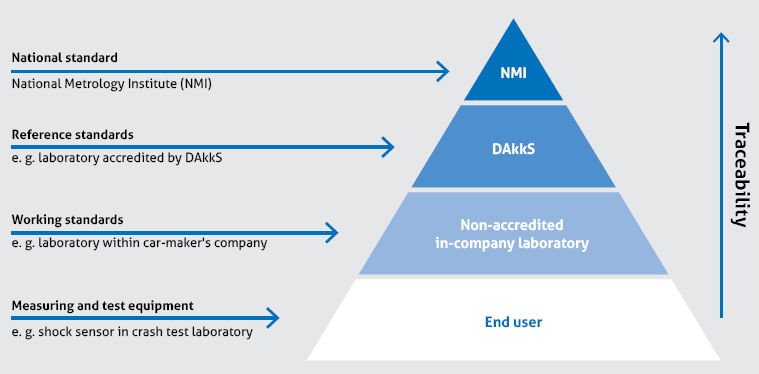
SPEKTRA Calibration Systems:
SPEKTRA CS18 and CS Q-LEAP™ Calibration Systems provides a means to cope with all requirements of traceable calibration and efficient laboratory operation in conformance with all applicable standards. Its performance, can be extended by means of optional extras and special accessories, such as possibility of integrating varied vibration or shock exciters.
Calibration Systems, Exciters and Components, Power Amplifier and Software from SPEKTRA includes:
- Vibration Calibration Systems
- Mobile Calibration Solutions
- Shock Calibration Systems
- Acoustic Calibration Systems
- Rotation Calibration Systems
- Calibration Exciters for Acceleration
- Calibration Exciters for Shock
- Calibration Exciters for Acoustic
- Calibration Exciters for Pressure
- Calibration Exciters for Rotation
- Power Amplifiers
- Calibration Solutions Software
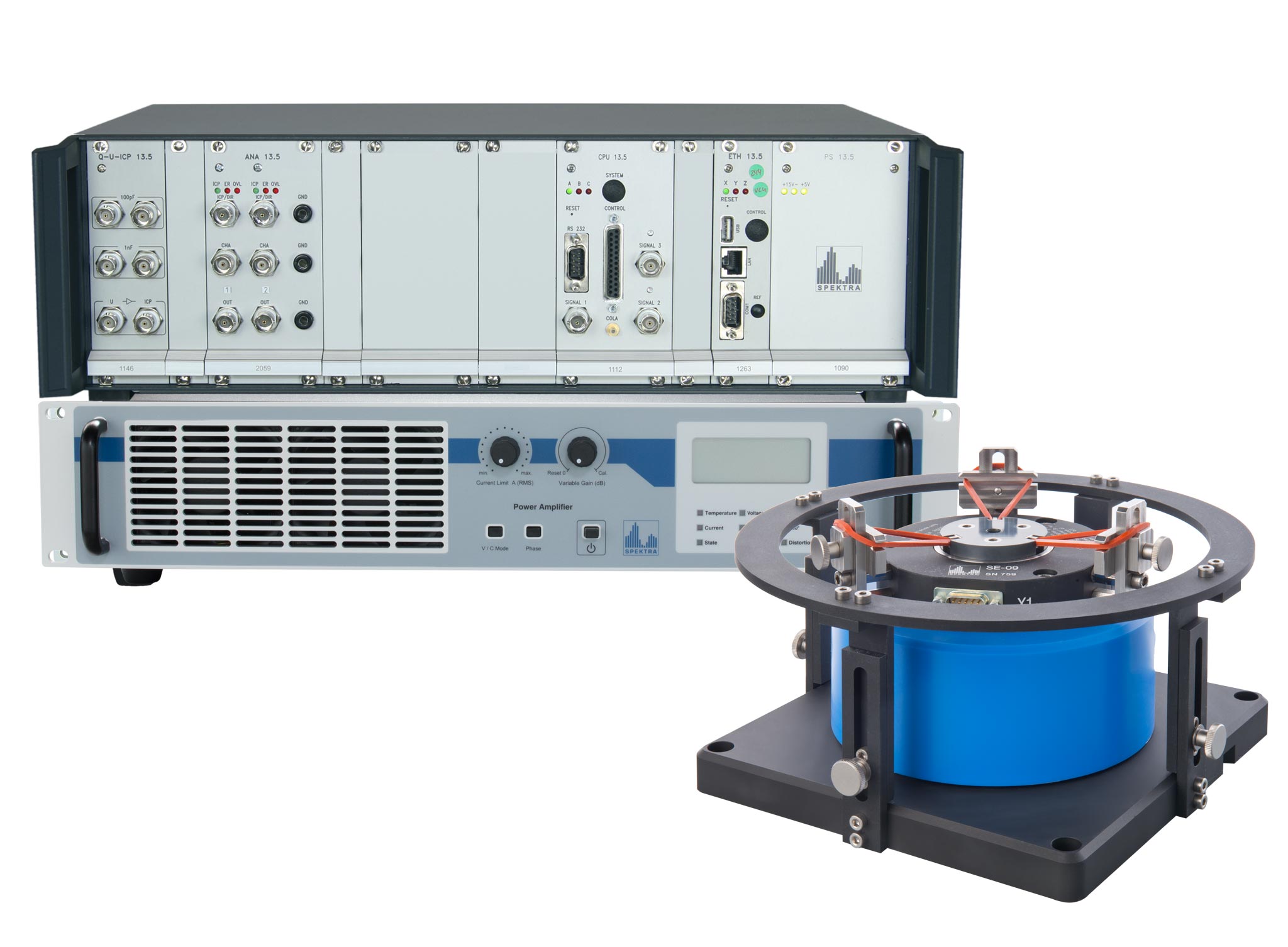
Options and Accessories:
For sensor calibration and other vibrational investigation, versatile accessories for mechanical and electrical adaptation are required, e.g.
- Small screws with diverse, metric and/or imperial threads for mounting the different sensor types onto the vibration exciter head.
- Electrical adaptors, sensor supply, PR/bridge-amplifiers, charge amplifiers
- Special sensor cables
- Mechanical adapters for mounting small and large DUTs onto vibration exciter
- Accessories for insertion of vibration into mechanical structures, e.g. stinger set
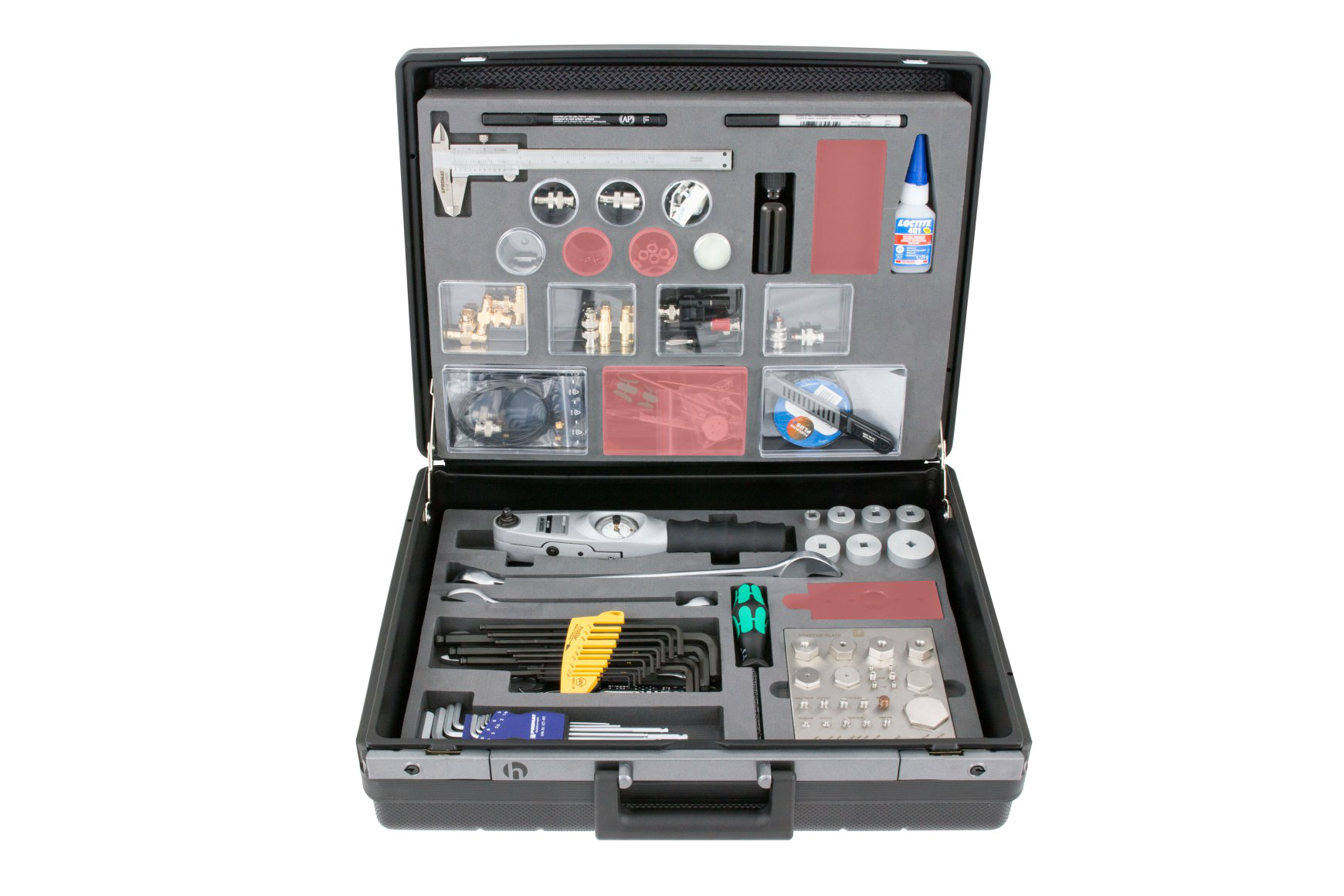
Vibration Calibration Systems
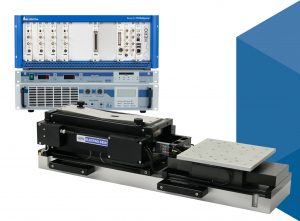
CS Q-LEAP™ SINE with APS 129
The CS Q-LEAP™ system is based on the HERO™ vibration controller and the APS 129 air bearing vibration exciter. It allows calibration of heavy seismic sensors (seismometers) as well as geophones.
- Frequency Range: DC – 200 Hz
- Stroke (peak-peak): 158 mm
- Force (sine peak): 133 N
- Operation: Horizontal or Vertical
- Max. Payload: 23.0kg (Horizontal), 11.0 kg (Vertical)
- Standards:
- ISO 16063-21 Calibration of vibration transducers by comparison to a reference transducer
- ISO 17025: General requirements for the competence of testing and calibration laboratories
- DIN 45669: Sensors for measurement of vibration immissions
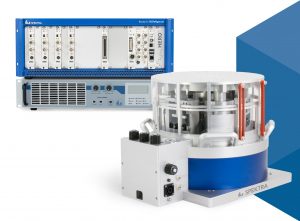
CS Q-LEAP™ SINE with SE-13
The CS Q-LEAP™ system is based on the HERO™ vibration controller and the SE-13 air-bearing electrodynamic vibration exciter. It allows calibration of heavy seismic sensors (seismometers) as well as geophones.
- Frequency Range: 0.2 Hz – 400 Hz
- Max. Stroke: 25 mm
- Max. Velocity: 300 mm/s
- Max Acceleration: 60 m/s²
- Operation: Vertical
- Max. Payload: Up to 50 kg
- Standards:
- ISO 16063 – 21: Calibration of vibration transducers by comparison to a reference transducer
- ISO 17025: General requirements for the competence of testing and calibration laboratories
- DIN 45669: Sensors for measurement of vibration immission
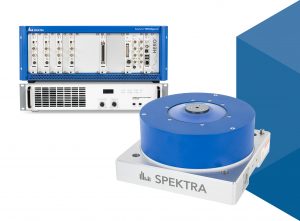
CS Q-LEAP™ SINE with SE-29
The CS Q-LEAP™ system is used for vibration calibration of a wide range of sensors including vibration sensors and measurement systems. It is based on the HERO™ vibration controller and the SE-29 high-frequency vibration exciter.
- Frequency Range: 3 Hz – 20 kHz – calibration mode (traceable), 20 Hz – 50 kHz – extended range for testing purposes
- Max. Acceleration: 450 m/s² peak
- Max. Force Rating: 95 N peak
- Max. Displacement: 10 mm
- Max. DUT Weight: 2 kg vertical / 1 kg horizontal
- Standards:
- ISO 16063 – 21: Calibration of vibration transducers by comparison to a reference transducer
- ISO 16063 – 44: Calibration of field vibration calibrators
- ISO 17025: General requirements for the competence of testing and calibration laboratories
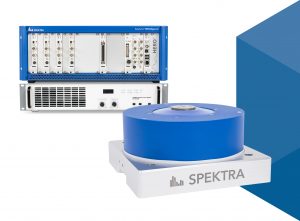
CS Q-LEAP™ SINE with SE-20
The CS Q-LEAP™ system is used for vibration calibration of a wide range of sensors including vibration sensors and measurement systems. It is based on the HERO™ vibration controller and the SE-20 high-frequency vibration exciter.
- Frequency Range: 3 Hz – 10 kHz – calibration mode (traceable), 10 Hz – 20 kHz – extended range for testing purposes
- Max. Acceleration: 600 m/s² peak
- Max. Force Rating: 95 N peak
- Max. Displacement: 10 mm
- Max. DUT Weight: 2 kg vertical / 1 kg horizontal
- Standards:
- ISO 16063 – 21: Calibration of vibration transducers by comparison to a reference transducer
- ISO 16063 – 44: Calibration of field vibration calibrators
- ISO 17025: General requirements for the competence of testing and calibration laboratories

CS Q-LEAP™ SINE with SE-09
The CS Q-LEAP™ system is based on the HERO™ vibration controller and the SE-09 high frequency exciter. It allows calibration of a wide range of vibration transducers and vibration calibrators.
- Frequency Range: 5 Hz – 20 kHz (…50 kHz without traceability)
- Max. Acceleration: 400 m/s² peak
- Max. Velocity: 0.5 m/s
- Max. Displacement: 7.5 mm
- Max. DUT Weight: 350 g
- Standards:
- ISO 16063 – 21: Calibration of vibration transducers by comparison to a reference transducer
- ISO 17025: General requirements for the competence of testing and calibration laboratories
Vibration Primary Calibration System
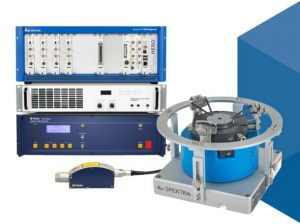
CS Q-LEAP™ P-SINE with SE-09
The CS Q-LEAP™ system is used for primary vibration calibration of a wide range of sensors including vibration sensors and measurement systems. It is based on the HERO™ vibration controller and the SE-09 high-frequency vibration exciter.
- Frequency Range: 5 Hz – 20 kHz (…50 kHz without traceability)
- Max. Acceleration: 400 m/s² peak
- Max. Velocity: 0.5 m/s
- Max. Displacement: 7.5 mm
- Max. DUT Weight: 350 g
- Standards:
- ISO 16063 -11: Primary calibration of vibration transducers
- ISO 16063 – 21: Calibration of vibration transducers by comparison to a reference transducer
- ISO 16063 – 41: Calibration of laser vibrometers
- ISO 17025: General requirements for the competence of testing and calibration laboratories
Mobile Calibration Solutions
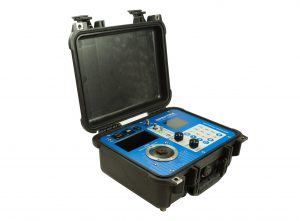
CV-10 Mobile Vibration Calibrator
Rugged, compact and easy to handle for everyday on-site calibration of accelerometers, proximity and vibration velocity sensors and many more.
- Frequency Range: 5 Hz – 10 kHz
- Max. Velocity (Sine Peak): 700 mm/s
- Max. Acceleration (Sine Peak): 200 m/s²
- Max. Displacement (peak-peak): 5 mm
- Standard Signal Conditioner: direct voltage input, IEPE, charge, 4 mA to 20 mA
- Max. Payload: 900 g
- Total Weight: 9 kg
- Up to 10 hrs battery operation
- Rugged case for daily on-site calibration
- Traceable to PTB, NIST etc

CV-05 Mobile Calibrator
The CV-05 is a mobile, battery-powered calibrator e.g. for on-site testing of human vibration measuring devices in accordance with ISO 8041. Highlights are the user-friendly interface, a high payload up to 300 g and the traceable DAkkS calibration certificate (corresponds to ILAC-MRA).
- Frequency: 79.58 Hz / 159.15 Hz
- Acceleration (m/s² RMS): 1; 2; 3; 4; 5; 6; 7; 8; 9; 10
- Displacement (μm RMS):
- 4; 8; 12; 16; 20; 24; 28; 32; 36; 40 (@ 79.58 Hz)
- 1; 2; 3; 4; 5; 6; 7; 8; 9; 10 (@ 159.2 Hz)
- Max. Payload: 300 g (0.66 lbs) resp. 200 g (0.44 lbs) – depending on frequency
Shock Calibration Systems
Shock Secondary Calibration System
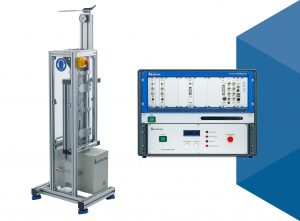
CS Q-LEAP™ SHOCK with SE-201
The CS Q-LEAP™ system is based on the HERO™ vibration controller and the SE-201 shock exciter. It enables secondary calibration of shock-sensors as well as complete measuring instruments with very high precision and efficiency, according to ISO 16063-22 and ISO 17025.
- Broad Amplitude Range: 49 m/s² to 98 km/s²
- Pulse width: 0.1 ms – 5 ms
- Automated regulation of amplitudes: up to 600 gn (6 km/s²)
- Max. payload: 80 g
- Standards:
- ISO 16063 – 22: Shock calibration by comparison to a reference transducer
- ISO 17025: General requirements for the competence of testing and calibration laboratories
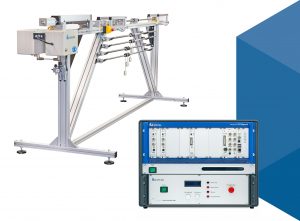
CS Q-LEAP™ SHOCK with SE-221
The CS Q-LEAP™ system is based on the HERO™ vibration controller and the SE-221 shock exciter. It enables secondary calibration of shock sensors as well as complete measuring instruments with very high precision and efficiency, according to ISO 16063-22 and ISO 17025.
- Broad amplitude range: 9.8 km/s² to 981 km/s²
- Pulse width: typical 23 μs to 19 μs
- Max. payload: 30 g
- With mitigator pulse widths up to 300 µs and for DUTs up to 200 g weight possible
- Reference standard: Use of strain gauges as well as laser vibrometers for primary calibration (option)
- Different bars for different DUTs
- Standards:
- ISO 16063 – 22: Shock calibration of vibration transducers by comparison to a reference transducer
- ISO 17025: General requirements for the competence of testing and calibration laboratories
Acoustic Calibration Systems
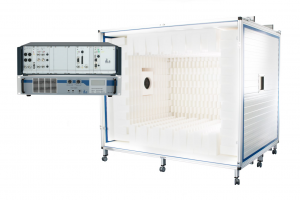
Free-Field Calibration 125 Hz to 20 kHz, CS18 FF
- Frequency Range: 125 Hz – 20 kHz
- Secondary calibration of measuring microphones, sound level meters and other acoustic sensors according to IEC 61094-8 and IEC 61672
- Periodic single qualification according to IEC 61672-3
- Calibration of calibrators according to IEC 60942
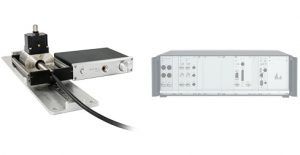
Pressure-Chamber Calibration 31.5 Hz to 16 kHz, CS18 SPL
- Frequency Range: 31.5 Hz – 16 kHz
- Pressure chamber secondary calibration of measuring microphones according to IEC 61094-5
- Pressure chamber secondary calibration of sound level meters and sound level measuring chains according to IEC 61672
- Calibration of acoustic calibrators and pistonphones according to IEC 60942
- Can be combined with anechoic chamber (upgrade free field calibration)
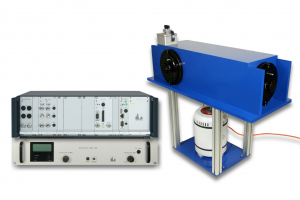
Infrasonic Calibration 0.1 Hz to 31.5 Hz, CS18 SPL-VLF
- Frequency Range: 0.1 Hz – 31.5 Hz
- Very low frequency calibration of pressure transducers and pressure measuring devices
- Pressure chamber secondary calibration of measuring microphones and microphone measuring chains
Rotation Calibration Systems
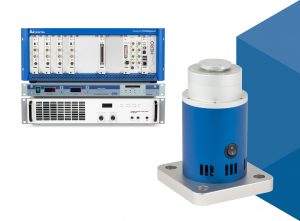
CS Q-LEAP™ Gyro with DRE-01
CS Q-LEAP™ calibration system with DRE-01 rotation exciter, HERO™ vibration control system, zero position controller, power amplifier and software. This system is used for the calibration of angular velocity sensors and measurement systems. Typical test items include gyro transducers (angular velocity), inertial measurement units (IMU) and rotation rate measuring systems.
- Frequency Range: 1 Hz – 200 Hz (traceable range for calibration), > 200 Hz – 5 kHz (extended range for testing purposes)
- Max. Payload: 0.5 kg
- Max. Angle (peak to peak): 30 °
- Max. angular velocity (sine peak): 5300 °/s
- Max. angular acceleration (sine peak): 2 500 000 °/s²
Calibration Exciters for Acceleration
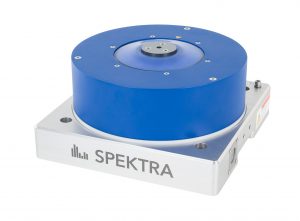
SE-29
Innovative high frequency vibration exciter with efficient electrodynamic drive. The SE-29 offers a very wide frequency range and low transverse motion. Thanks to the wide temperature range and the high payload, the SE-29 is optimally suited for larger sensors or geophones. Besides high quality components, the focus lays on a versatile field of application and easy implementation into existing test environments.
- Frequency Range: 3 Hz to 50 kHz (with optional internal reference standard)
- Max. Acceleration (sine-peak): 450 m/s2
- Max. Force (sine-peak): 95 N
- Max. Displacement (peak-peak): 10 mm
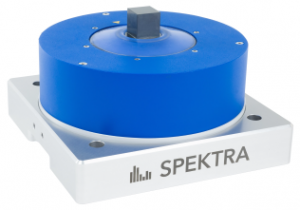
SE-21
With its electrodynamic drive system, the SE-21 offers a very wide frequency range with low transverse motions. A high payload, simple operation in a climatic chamber (as SE-21T) and the many extensions enable the SE-21 to be used as a multi-tool for testing, characterizing and calibrating vibration sensors or smaller electronic devices.
- Frequency Range: 3 Hz to 50 kHz (with optional internal reference standard)
- Max. Acceleration (sine-peak): 390 m/s2 For SE-21, 350 m/s2 For SE-21T
- Max. Force (sine-peak): 95 N
- Max. Displacement (peak-peak): 10 mm
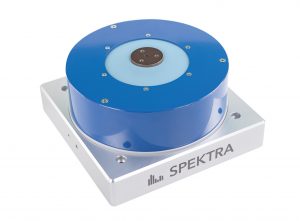
SE-20
The SE-20 offers a very wide frequency range, low transverse motion, wide temperature range and high payload. In addition to top quality components, the focus is on a versatile user field and easy implementation in existing test environments.
- Frequency Range: 3 Hz to 20 kHz (with optional internal reference standard)
- Max. Acceleration (sine-peak): 600 m/s2
- Max. Force (sine-peak): 95 N
- Max. Displacement (peak-peak): 10 mm
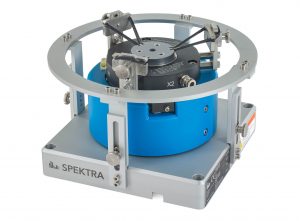
SE-09
The air-bearing SE-09 high-frequency calibration exciter is a high-tech product developed especially for the high demands of calibration laboratories and metrology institutes as well as for characterization of MEMS sensors.
- Frequency range: DC – 50 kHz (internal reference standard 5 Hz – 50 kHz)
- Resonance Frequency: 52 kHz
- Max. Force: 100 N
- Max. Displacement (peak-peak): 8 mm
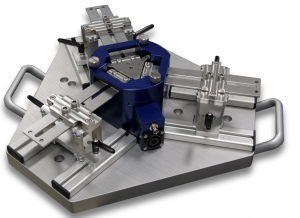
SE-101 RES-HA
The vibration exciter SE-101 RES-HA is deliberately operated in a certain resonance to cost-effectively generate harmonic acceleration-time signals with very high acceleration amplitudes with a compact 100 N drive. Main applications are amplitude linearity tests of sensors or vibration testing of small components at high accelerations.
- Frequency Range: 70 Hz – 500 Hz
- Max. Acceleration: 4000 m/s2
- Max. Stroke: 10mm
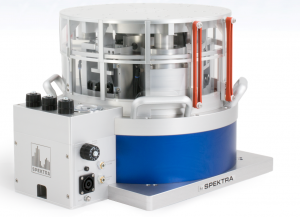
SE-13
Air-bearing electrodynamic Vibration Exciter with mounting table for high payloads up to 50 kg. Especially developed for the calibration and testing of big and heavy low frequency seismic sensors as well as geophones.
- Frequency Range: 0 – 400 Hz
- Max. Acceleration: 60 m/s2 peak
- Max. Force: 500 N
- Max. Displacement (peak-peak): 25 mm
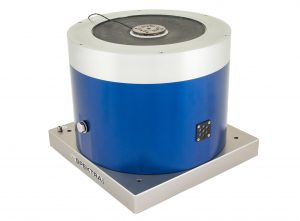
SE-14
Spring-guided vibration exciter that is suitable for daily use in the calibration laboratory as well as for vibration tests.
- Frequency Range: 0 – 8 kHz
- Max. Acceleration: 500 m/s2
- Max. Force: 265 N
- Max. Displacement (peak-peak): 20 mm
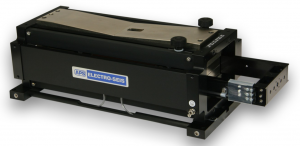
APS 113-AB
Air-bearing ELECTRO-SEIS® Long Stroke vibration exciter – especially developed for the calibration and testing for low frequency sensors and sensor characterization.
- Frequency Range: 0 – 200 Hz
- Max. Force: 133 N (optional: 186 N)
- Max. Displacement (peak-peak): 158 mm
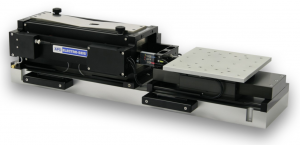
APS 129
Air-bearing ELECTRO-SEIS® Long Stroke Vibration Exciter with mounting table for high payloads up to 23 kg. Especially developed for the calibration and testing of big and heavy low frequency sensors as well as for sensor characterization.
- Frequency Range: 0 – 200 Hz
- Max. Force: 133 N (optional: 186 N)
- Max. Displacement (peak-peak): 158 mm
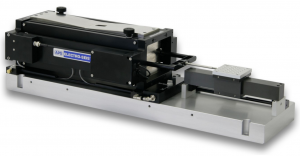
APS 500
Air-bearing ELECTRO-SEIS® Long Stroke vibration exciter with mounting table for payloads up to 3 kg. Especially developed for the calibration and testing of compact low frequency sensors and for sensor characterization at higher acceleration.
- Frequency Range: 0 – 200 Hz
- Max. Force: 95 N
- Max. Displacement (peak-peak): 152 mm
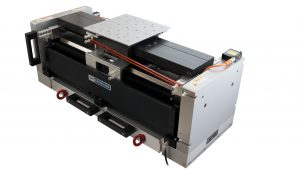
APS 600
Air-bearing ELECTRO-SEIS® Long Stroke vibration exciter with mounting table for very high payloads. Especially developed for the calibration and testing of geophones and heavy seismic sensors.
- Frequency Range: DC – 50 Hz
- Max. Force: 215 N
- Max. Displacement (peak-peak): 450 mm
Calibration Exciters for Shock
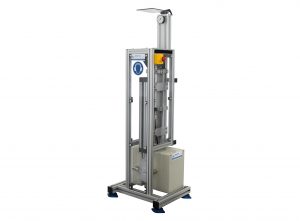
SE-201
Calibration of shock transducers as well as complete measuring instruments (measuring chain) with very high precision and efficiency.
- Pneumatically driven shock exciter
- NEW: dynamic shock pressure calibration possible
- Min. Shock Amplitude: 5 gn
- Max. Shock Amplitude: 10,000 gn
- Pulse Duration (typically): 0.1 ms – 5 ms
- Max. Sensor Mass (DUT): 80 gram
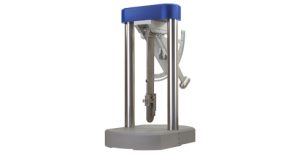
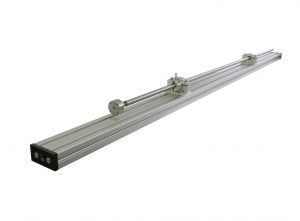
SE-220 HOP-MS
The SPEKTRA HOP-MS shock exciter is for testing and calibrating acceleration sensors as well as for environmental testing of small assemblies and parts.
- Patent-protected Medium-shock exciter
- for the amplitude range from 20 gn up to 4,000 gn.
- Provides the force impact using a piezo-actuator.
- Adjustable signal shape, amplitude, pulse width
- This allows new possibilities to control the mechanical shock signal and with its new applications in the field of the calibration and in particular in the field of measurement and test systems (e.g. to test the shock sensibility of MEMS sensors).
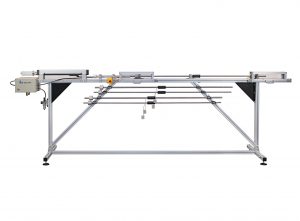
SE-221
Shock exciter for testing and calibration of shock transducers as well as complete measuring instruments (measuring chain) according to ISO 16063-22.
- Shock Amplitude: 1,000 to 100,000 gn (High shock bar), 5,000 to 200,000 gn (Very High shock bar)
- Sensor mass (DUT), max.: 15 g / 30 g (depending on selection of Hopkinson-bar)
- Sinusoidal shock as type of excitation
- Realization of all automatic calibrations according to own test regime (up to 20 shocks/minute)
- Secondary calibration of shock transducers and measuring chains according to ISO 16063-22
- Secondary calibration of shock accelerometer reference standards
Calibration Exciters for Acoustic
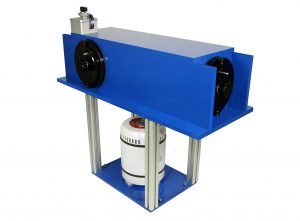
Pressure Generator, SQ-03
Very low frequency calibration of pressure transducers and pressure measuring devices
- Frequency Range 0.3 Hz – 31.5 Hz
- True pressure chamber calibration with an acoustic calibrator
- Calibration of pressure transducers
- Calibration of all established measuring microphones (capacitor and electrets microphones, …)
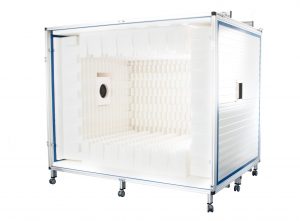
Compact anechoic chamber, SQ-101
Can be installed in any room without construction work
- Frequency Range 125 Hz – 20 kHz
- Sound Pressure Range: 64 dB – 124 dB
- Calibration of microphones according to DIN EN 61094-8
- Calibration of sound level meters according to DIN EN 61672
- Periodic tests of sound level meters according to DIN EN 61672-3 (incl. electrical tests)
- Calibration of calibrators according to DIN EN 60942
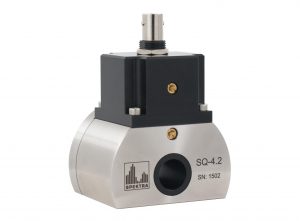
Electro-Acoustic Coupler, SQ-4.2
True pressure chamber calibration with an acoustic coupler
- Frequency Range: 31.5 Hz – 20 kHz
- Sound Pressure Level: 74 dB – 134 dB (Frequency-dependent)
- True pressure chamber calibration for 1/2 and 1/4* inch microphones
- Acoustic coupler available for 1 inch microphones
* max. frequency of 2 kHz for 1/4 inch microphones
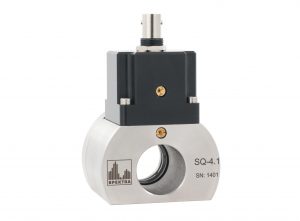
Electro-Acoustic Coupler, SQ-4.1
True pressure chamber calibration with an acoustic coupler
- Frequency Range: 31.5 Hz – 8 kHz
- Sound Pressure Level: 64 dB – 94 dB
- True pressure chamber calibration for 1 inch microphones
Calibration Exciters for Pressure
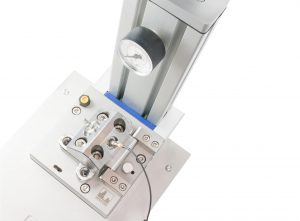
Dynamic Pressure Exciter, DPE-02 (2 MPa to 420 MPa)
Generates pressure shock impulses with low pulse duration (<2 ms)
- Amplitude: 2 MPa – 420 MPa
- Shock Duration: 0.5 – 2 ms
- Medium: Oil
- Realization of all automatic calibrations according to own test regime (up to 1 shock/s)
- User-friendly and efficient
- Upgradeable to a shock acceleration calibration device
- Dynamic calibration of pressure sensors
- Dynamic tests of pressure sensors
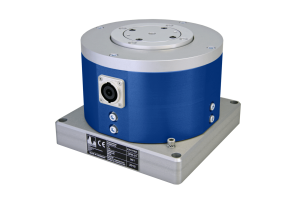
Dynamic Pressure Exciter, DPE-01 (100 Pa to 16 kPa)
Dynamic pressure exciter for secondary calibration of pressure sensors.
- Pressure Range: 16 kPa (0.16 bar)
- Frequency Range: DC – 1.25 kHz
- Pressure Amplitude: 100 Pa to 16 kPa
- Medium: Air
Calibration Exciters for Rotation
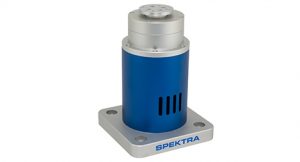
Dynamic Rotation Exciter, DRE-01
The DRE-01 dynamic rotation exciter is used for calibration of gyro transducers (angular velocity/acceleration) and for characterization of MEMS sensors. It features very low motion distortion, built-in overload protection and cooling for improved performance, and can be operated with any signal generator or vibration controller.
- Frequency Range: 1 Hz – 5 kHz
- Max. Payload: 0.5 kg
- Max. angular velocity (sine peak): 5300 °/s
- Max. angular acceleration (sine peak): 2 500 000 °/s²
- Total Harmonic Distortion (Angular Velocity): 1 Hz – 6 Hz: <10%, 6 Hz – 5 kHz: <3%
- Electro-dynamic Drive
Power Amplifiers
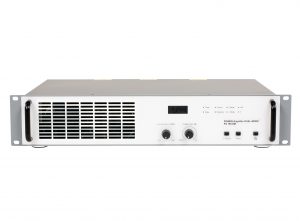
PA180 DM
For all vibration exciters that require a 180 VA power amplifier (load impedance 0.8 Ω). The PA 180 DM offers a max. frequency range DC to 100 kHz, small harmonic distortion, excellent stability even with temperature or supply line variations and helpful protection functions.
- Frequency Range: 40 Hz to 20 kHz (at full power), DC to 100 kHz (small signal)
- Max Power Output: 180 VA into a 0.8 Ω resistive load
- High reliability operation
- Switch between voltage and current mode
- Phase Shift (0° or 180°)
- Variable gain control
- Current limit control
- Temperature protection
- Multifunction OLED display
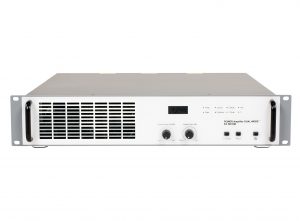
PA 500 DM
For all vibration exciters that require a 500 VA power amplifier (load impedance 4 Ω). The PA 500 DM offers a max. frequency range from DC to 200 kHz, small harmonic distortion, excellent stability even with temperature or supply line variations and helpful protection functions.
- Frequency Range: 40 Hz to 60 kHz (at full power), DC to 200 kHz (small signal)
- Power output, max.: 500 VA into a 4 Ω resistive load
- Switch between voltage and current mode
- Phase shift (0° or 180°)
- Variable gain control
- Current limit control
- Temperature protection
- Multifunction OLED display
- Range of Use: R&D departments in industry, environment testing laboratories, calibration laboratories, universities and research institutes
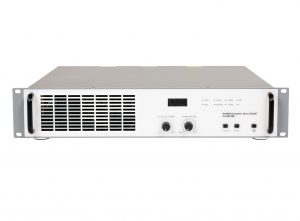
PA 800 DM
For all vibration exciters that require a 810 VA power amplifier (load impedance 2.5 Ω). The PA 800 DM offers a max. frequency range from DC to 25 kHz, small harmonic distortion, excellent stability even with temperature or supply line variations and helpful protection functions.
- Frequency Range: 20 Hz to 15 kHz (at full power), DC to 25 kHz (small signal)
- Power output, max.: 810 VA into a 2.5 Ω resistive load
- High reliability operation
- Switch between voltage and current mode
- Phase shift (0° or 180°)
- Variable gain control
- Current limit control
- Temperature protection
- Multifunction OLED display
- Range of Use: R&D departments in industry, environment testing laboratories, calibration laboratories, universities and research institutes
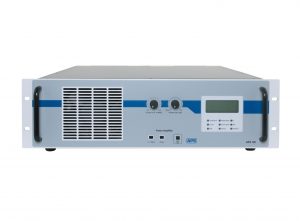
APS-145
800 VA power amplifier for low-frequency vibration exciters
- 800 watt power amplifier for modal shakers and environmental analysis
- DC coupled amplifier
- Voltage and power mode
- Fitted to suit the vibration exciters APS 400, APS 420 and APS 600
- Safety appliances fitted to used exciter
Options and Accessories
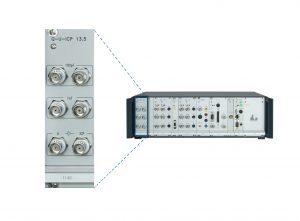
CAL-Q-U-ICP
-
Software extension for calibration of signal conditioners (payload-, IEPE-, measuring amplifiers); In conjunction with the optional extra PHASE also applicable to PHASE calibration of signal conditioners
- Optional extra CAL-Q-U-ICP is available for each of the CS18 calibration systems. This complementary set of hardware and software enables charge, voltage and IEPE amplifiers as well as microphone pre-amplifiers to be calibrated with respect to amplitude and phase.
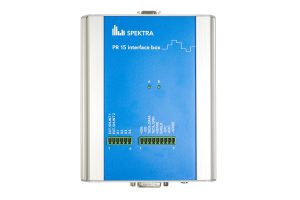
PR-Measurement
- Signal conditioners and software for PR-sensors;
- Optional extra for vibration calibration systems CS18 for the calibration of piezo-resistive sensors. Includes a PR signal conditioner power supply of piezoresistive (bridge), variable capacitance and similar sensors
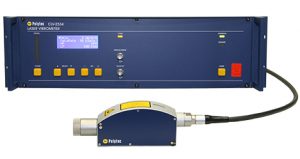
Laser Vibrometers
-
Calibration of laser vibrometers
Optical components and software for calibration according to ISO 16063-41
- All primary calibration systems by SPEKTRA include a laser vibrometer standard traced back to PTB and so are suited to the calibration of laser vibrometers and digital laser vibrometer standards.
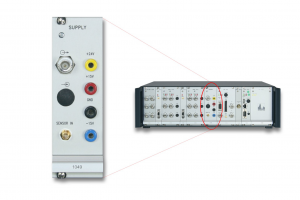
Sensor Supply Internal
- Provides proper connection of several kinds of sensors to a voltage input of a measurement device (here: CS18 VCU). Sensor is plugged in at input. Signal output is connected to CS18 VCU input. Provides DC supply voltage(s) for sensor and performs signal preconditioning
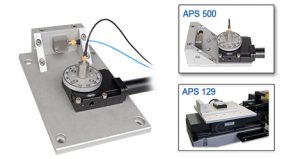
TRANS for CS18 VLF (primary and secondary)
- Used for hardware and software to determine the cross-sensitivity of sensors
- CS18 TRANS as an optional extra to a type CS18(P) VLF calibration system for determining the transversal transfer coefficient as a function of operating angle. It is intended for operation in conjunction with an APS 129 or APS 500 air bearing long stroke vibration exciter in the frequency range between 2 Hz and 50 Hz.
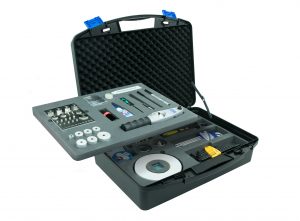
CS Accessories Case
- Assortment of standard accessories for calibration work of vibration sensors in the laboratory. The set includes suitable tools, adapters and necessary auxiliary material for careful and effective sensor calibration.
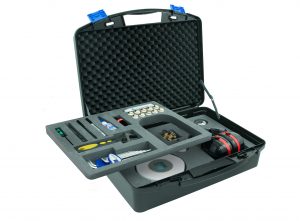
CS Accessories Case High Shock
- Set with special accessories for calibration work with the HOP-HS shock exciter (High Shock). The case includes suitable tools, adapters, auxiliary materials and protective utensils for a careful and effective calibration of shock sensors in the laboratory.
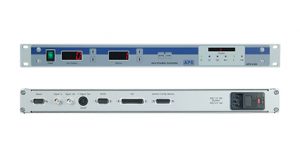
APS 0109
- The APS 0109 Zero Position Controller automatically controls the zero position of a vibration exciter irrespective of its load. It is essential to employ a position controller of type APS 0109 especially when working with an air-bearing vibration shaker without any integrated automatic load-compensation
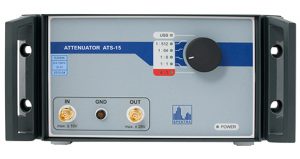
Attenuator, ATS-15
- Part of electrical final test and calibration bench
- Division Ratio: 1:1, 1:8, 1:64, 1:512
- Frequency Range: 0 Hz – 100 kHz
- Accuracy: Up to 0.015 %
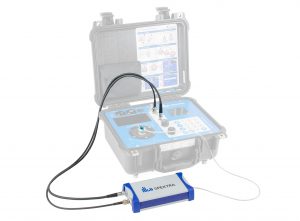
CV-10 PR
- CV-10 Extension Module for piezoresistive (PR) Sensors
- Is recognized independently after connection to the CV-10 and displayed as an additional signal conditioner
- Comfortable operation through automatic gain and offset adjustment as well as flexibly adjustable bridge volt up to ±10 V
- Provides the electrical excitation voltage for the sensor and amplifies the sensor’s output signal.
- The extension module is powered by the CV-10 via a connection to the extension port and neither needs nor allows any other external voltage supply
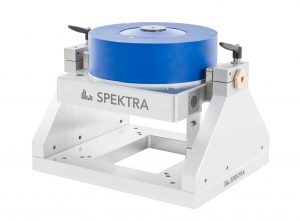
SE-2x Trunnion Base
Allows the vibration axis of the exciter (SE-20, SE-21 and SE-29) to be tilted and locked at any angle between 0° and 90° from the vertical axis.
- Calibration of sensors that must be used in a specific orientation to the earth’s gravity field
- To excite structures under test (e.g. for modal analysis)
- Quick and easy change between vertical and horizontal operation with good repeatability
- Suspension of the vibration exciter by means of eyebolts screwed into the tilting frame
- For SPEKTRA vibration exciters SE-20, SE-21 and SE-29
- Dimensions (H × B × L): 230 mm × 375 mm × 300 mm (9.0 in × 14.8 in × 11.8 in)
- Weight: ca. 15 kg (33 lbs)
- Material: Aluminium
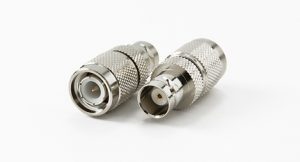
Adapters and Cables:
- Mounting & Adhesive Mounting Adapters
- Adapter Sets and Plates
- Cables
- Connectors
- Mounting Studs and Bushings
- Other (Test Thread and Zero Position Spacer)
Calibration Solutions Software
CS Q-LEAP™ Software
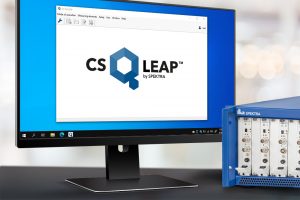
Every good hardware needs a high-performing software.
The CS software was created in close cooperation with the SPEKTRA Calibration laboratory accredited by DAkkS. It meets the demands of every efficiently operating calibration laboratory already in its basic configuration and can easily be adapted to the workflows of any company.
- Simple to operate
- Integrated sensor database
- Data export to Word®, Excel®, …
- Automation interface
- Calibration database server (Optional)
- Interface to foreign databases (Optional)
- Calibration of digital sensors (e. g. DTI)
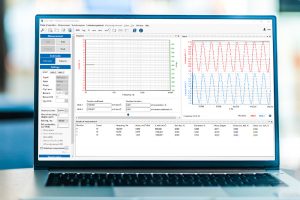
Extensive operating modes
- Sensor calibration – allows the calibration of a wide range of sensors.
- Sweep – helps to establish whether a tested sensor can actually be calibrated.
- Measurement – for the calibration of vibration calibrators.
- Generation – designed to generate one of the vibration quantities with high precision.
- Primary calibration tasks – calibration, measurement and generation
- Self-test for the HERO™ vibration control unit*.
- *for CS Q-LEAP™ systems
eCAL™ Software Application
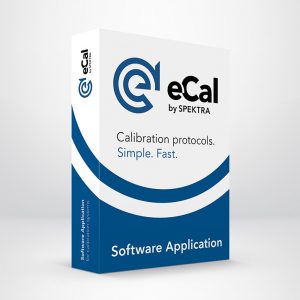
Calibration protocols. Quick. Easy.
The eCal™ software application has been specially developed by SPEKTRA for calibration laboratories. eCalTM is simultaneously a universal calibration protocol viewer and a data transformation tool.
The application can transfer calibration data from various programs such as the SPEKTRA CS18 or CS Q-LEAPTM calibration systems into standardized output formats for digital distribution or printing. One dataset can therefore be used to generate calibration certificates in print form as well as digital calibration certificates, or to provide data for further processing in databases – all with the same ease. Further modules will be added to eCalTM in the future to allow post-processing of documents (signing, release, document storage, etc.) and workflows.
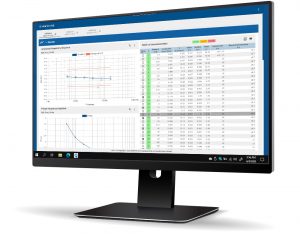
eCal™ – Calibration tasks made easy
- Read calibration data from a variety of input sources
- Represent calibration data in an internal, extendable data format
- Load multiple calibration protocol files with one click
- Templates for a concise display of calibration data in diagrams and tables
- Enables editing of order data without affecting the measurement data
